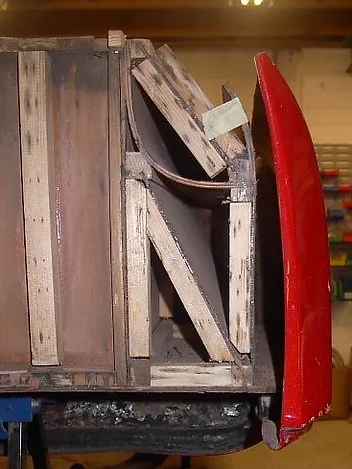

MARCOS WOODEN CHASSIS
Over recent years we have been monitoring the condition of all the wooden chassis cars that have been through our workshops.
The reason for this is to be able to advise owners of these early cars what to watch for as far as the woodwork is concerned. We have all heard the “woodworm and dry rot” jokes and I am for ever being asked about the longevity and problems experienced with a wooden chassis, so here is a qualified report on what I have discovered with cars up to 36 years old.
The main problem is the “cowboy repair” and I quote one owner I confronted (who must remain anonymous). “I thought it would be stronger with steel plates either side of the wood".
Do not try to improve the wooden chassis, it is a masterpiece, it works extremely well as it is (you wouldn’t flare the wheel arches on a Ferrari 275 GTB4!). So the moral here is if you have damage to the chassis,- repair as per original. The most common reason for damage to the chassis is the fitting of oversize wheels and tyres, and too much power. The chassis was designed to cope with up to approx. 125 bhp delivered through 175x13 tyres, which limits the torque reaction set up in the chassis to the adhesion of the tyre in contact with the road surface. If this ratio is altered then problems will occur. Increase the power output by all means but limit the forces transmitted through the chassis by keeping the tyre size to a minimum. The wooden chassis Marcos is a finely balanced instrument and will not adapt kindly to “gross appendages” (wheels).

The second and only other real problem with the wooden chassis is water. It is perfectly capable of withstanding any amount of wet weather use and does not need any special attention in that area. What it will not tolerate is water saturation, as over a fairly short period of time it can rot. This is generally caused by, either the doors, or the screens leaking, allowing water to collect inside the car for long periods, which will then migrate into the structure and start to delaminate the plywood . Once this starts the only remedy is to remove the damaged area and replace. Do not be tempted to try to seal or waterproof the inside surfaces of the car, these are left “open” to allow the wood to breathe, the only way is to try and stop the ingress of water before it can do any damage.
A difficult job at the best of times.

The problem areas simply go to prove what a remarkable structure the wooden chassis is, from its introduction in the two seater configuration in 1964, until its demise in 1969 the wooden chassis has more that proven itself as a far superior alternative to steel, in fact many of the later metal chassis cars are already on their second chassis. The 1800 version is still winning races in the classic series and will continue to do so for many years to come.
So, in conclusion, whether you are thinking of buying a wooden chassis Marcos or are lucky enough to own one already, there is no need to worry about the upkeep and maintenance of the chassis. Providing it does not suffer from any of the problems I have outlined, I have no doubt it will give years of pleasure and service. Should you need further help or information on any Marcos problems please do not hesitate to contact me, the wooden chassis is a very specialist thing, come to the experts we have the experience. Why not book the car in for a check over and report.
